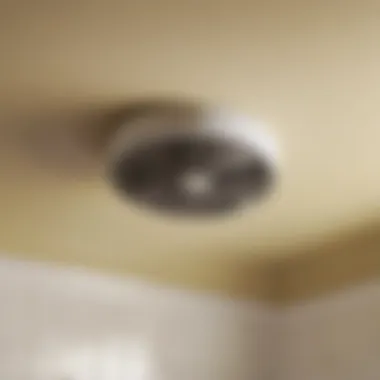Expert Guide: How to Successfully Install a Bathroom Fan


Materials:
- Bathroom fan unit: 1 unit of 110 CFM fan with a 4-inch duct connection
- Duct pipe: 1 piece of 4-inch duct pipe to channel air outside
- Connector and screws: To securely attach the duct pipe to the fan
- Voltage tester: To ensure electricity is turned off before starting
- Drill and bits: For making necessary holes in the ceiling or wall
- Screwdriver: To secure the fan in place
- Wire stripper: For correctly connecting electrical wires
- Safety goggles and gloves: To protect eyes and hands during installation
- Ladder: To reach the installation spot safely
DIY Steps:
- Turn off electricity: Begin by turning off the power supply to the bathroom to avoid any electrical accidents.
- Plan the location: Choose a spot in the bathroom ceiling that allows for optimal air circulation and is close to an electrical connection.
- Mark the cut-out: Using the template provided with the fan unit, mark the cut-out dimensions on the ceiling or wall where the fan will be installed.
- Cut the opening: Carefully cut out the marked area using a saw, following the outlined dimensions.
- Install the fan unit: Securely mount the fan unit in the cut-out opening and connect the duct pipe to the fan.
- Connect electrical wiring: Use the voltage tester to ensure no power is flowing, then connect the fan's wiring to the electrical source.
- Secure the duct pipe: Attach the duct pipe to the fan and secure it in place using connectors and screws.
- Test the fan: Turn the power back on to test the fan's functionality and ensure proper ventilation.
Technical Aspects:
- Timing: Allow approximately 1-2 hours for the entire installation process, depending on complexity.
- Tools: Ensure you have all necessary tools mentioned above to facilitate a smooth installation.
- Techniques: Practice precision when cutting the opening and connecting electrical wires to ensure a safe and efficient installation.
Troubleshooting Tips:
- If the fan is noisy, check for any loose connectors and tighten them accordingly.
- Inadequate airflow may indicate a blockage in the duct pipe, requiring a thorough inspection and cleaning.
- If the fan fails to turn on, double-check the electrical connections and ensure the power source is functioning correctly.
Introduction
In the realm of home improvement, the often underrated yet crucial aspect is the installation of a fan in the bathroom. This article serves as a definitive guide on navigating the intricate process of installing a bathroom fan. Understanding the significance of proper ventilation can not be overstated, as it directly impacts the overall health and maintenance of your home environment. From preventing mold and mildew growth to improving indoor air quality and removing excess moisture, the need for a bathroom fan becomes paramount. By delving into the purpose of bathroom ventilation, one can unearth the plethora of benefits that come with this essential installation.
Purpose of Bathroom Ventilation
Preventing Mold and Mildew Growth
When addressing the issue of preventing mold and mildew growth, one must recognize the detrimental effects these unwelcome guests can have on both the aesthetics and structural integrity of a bathroom. Mold and mildew thrive in damp environments, making bathrooms with inadequate ventilation prime breeding grounds for these nuisances. By installing a bathroom fan, you create a consistently dry atmosphere that inhibits the growth of mold and mildew, preserving the longevity and cleanliness of your bathroom.
Improving Indoor Air Quality
Indoor air quality is a silent yet critical component of a healthy living space. Poor ventilation in bathrooms can lead to the accumulation of airborne contaminants, ranging from toxins to excessive humidity. With a well-functioning fan in place, you can effectively circulate fresh air, mitigating the risk of respiratory issues and creating a more pleasant bathroom experience for all occupants.
Removing Excess Moisture
Excess moisture in a bathroom not only fosters the growth of mold and mildew but also poses a threat to the overall infrastructure of the space. By expelling moisture through the ventilation system, a bathroom fan prevents the buildup of condensation on walls, ceilings, and fixtures. This proactive measure not only maintains the structural integrity of your bathroom but also enhances its hygiene quotient, ensuring a comfortable and long-lasting environment for daily use.
Benefits of Installing a Bathroom Fan
Enhanced Comfort
The installation of a bathroom fan goes beyond functional necessity and extends to enhancing the overall comfort of your living space. By regulating humidity levels and air quality, a bathroom fan creates a more inviting atmosphere, free from the stuffiness often associated with inadequate ventilation. Additionally, the reduction of odors and airborne particles adds a layer of comfort that elevates the bathroom experience for residents and guests alike.


Increased Energy Efficiency
Contrary to common belief, a bathroom fan contributes significantly to the energy efficiency of your home. By effectively controlling humidity levels and preventing moisture-related issues, the fan reduces the workload on your HVAC system, ultimately resulting in lower energy consumption. This dual functionality of maintaining air quality while optimizing energy usage makes a bathroom fan a cost-effective and eco-friendly addition to your household.
Preventing Structural Damage
Unseen but potentially catastrophic, structural damage caused by moisture buildup is a legitimate concern for any homeowner. A bathroom fan acts as a proactive shield against such issues, safeguarding your walls, ceilings, and fixtures from the wear and tear of prolonged exposure to excess humidity. By preventing structural damage, the fan not only preserves the aesthetics of your bathroom but also ensures the longevity and value of your property.
Preparation
Preparing for the installation of a bathroom fan is crucial to ensure a successful outcome. By laying the foundation with proper planning and readiness, you can streamline the process and avoid potential issues. The preparation phase involves gathering all the necessary tools and materials, understanding safety precautions, and familiarizing yourself with the installation steps. This section will delve into the importance of thorough preparation and its impact on the installation process.
Tools and Materials Needed
Screwdriver:
When it comes to installing a bathroom fan, a screwdriver is an indispensable tool. Its versatility in tightening and loosening screws plays a key role in securing various components of the fan unit. The ergonomic design of a screwdriver allows for precise control and efficient fastening, essential for a stable installation. A reliable screwdriver enhances the user experience by reducing the effort required for assembly tasks. However, improper use of a screwdriver can lead to stripped screws or damage to the fan components, highlighting the importance of using the right tool for the job.
Drill:
A drill is essential for creating openings for the fan unit and ventilation duct. Its power and speed facilitate swift and accurate drilling, ensuring proper fitting of components. The key attribute of a drill is its ability to penetrate different surfaces, from drywall to tiles, with ease. This versatility makes it an ideal choice for bathroom fan installations, where precision and speed are paramount. Despite its effectiveness, a drill requires careful handling to prevent accidents or damage to surrounding structures.
Duct tape:
Duct tape serves as a versatile adhesive and sealing material during the installation of a bathroom fan. Its strong adhesive properties enable it to securely fasten components, such as connecting the ventilation duct to the fan unit. The flexibility of duct tape allows for seamless wrapping and sealing of joints, preventing air leaks. However, it is essential to use high-quality duct tape to ensure durability and long-lasting performance in humid environments like bathrooms.
Fan unit:
The fan unit is the heart of the ventilation system, responsible for extracting moisture and odors from the bathroom. Its efficient motor and fan blades ensure optimal airflow, enhancing air quality and comfort. The key characteristic of a quality fan unit lies in its noise levels and extraction capacity, as these factors influence user experience. Choosing a reputable brand for the fan unit guarantees reliability and longevity, crucial for maintaining a healthy indoor environment.
Ventilation duct:
The ventilation duct channels the extracted air from the fan unit to the exterior of the building. Its size and material composition impact the airflow efficiency of the ventilation system. Opting for a properly sized and insulated ventilation duct reduces air resistance and noise levels, promoting effective ventilation. The unique feature of a ventilation duct lies in its ability to withstand moisture and temperature fluctuations, ensuring continuous airflow without clogs or damage.
Safety Precautions
Turn off electricity:
Before commencing the installation process, it is essential to turn off the electricity supply to the bathroom. This precaution prevents the risk of electric shocks or short circuits during the operation. By cutting off the power source, you ensure a safe working environment and protect both yourself and the electrical components from potential damage.
Wear protective gear:


Wearing appropriate protective gear, such as safety goggles and gloves, shields you from debris and sharp edges while handling tools. The key characteristic of protective gear is its ability to minimize the risk of injuries and exposure to hazardous materials. By prioritizing safety during the installation, you reduce the chances of accidents and ensure a secure work environment.
Work in a well-ventilated area:
Working in a well-ventilated space is vital to reduce exposure to dust and fumes generated during the installation process. Proper ventilation maintains air quality and prevents the accumulation of harmful particles in the environment. The unique feature of a well-ventilated area is its ability to promote comfort and respiratory health, enhancing overall safety and well-being. By choosing a well-aerated workspace, you safeguard your health and enhance the efficiency of the installation process.
Installation Process
In the installation process of a bathroom fan, meticulous attention to detail is essential to ensure optimal functionality and efficiency. This crucial stage sets the foundation for proper ventilation in the bathroom, addressing issues like excess moisture, mold, and mildew growth. By installing a bathroom fan correctly, you not only enhance the indoor air quality but also contribute to a more comfortable and energy-efficient environment within your home.
Locating the Installation Spot
Near the shower or bathtub
Locating the bathroom fan near the shower or bathtub is strategically significant as it targets areas with high humidity levels. This position allows the fan to effectively remove steam and excess moisture generated during showers or baths, preventing condensation and mold formation. Choosing this location ensures that the fan operates efficiently to maintain a dry and healthy bathroom environment. Although proximity to water sources is crucial for optimal performance, it is essential to consider safety regulations and electrical requirements.
Avoid Obstructions
Avoiding obstructions in the installation spot is vital to allow proper airflow and ventilation. Placing the fan in a clear, unobstructed area enables it to function efficiently without hindrances, ensuring the effective removal of damp air from the bathroom. By ensuring there are no blockages or barriers around the fan, airflow is optimized, and the ventilation system operates at peak performance. This strategic placement enhances the functionality of the fan and promotes healthy air circulation throughout the space.
Cutting the Opening
Measure and Mark the Spot
Accurate measurement and marking of the spot for the fan installation are pivotal steps in ensuring a precise and secure fit. By measuring the designated area systematically, you guarantee that the opening accommodates the fan unit without any issues. Marking the spot provides guidance for cutting and helps maintain the integrity of the surrounding structure. This meticulous approach minimizes errors and simplifies the installation process, leading to a seamless and professional finish.
Use a Saw to Cut the Opening
Utilizing a saw to cut the opening follows precise measurements, allowing for a clean and accurate incision. The choice of a suitable saw ensures smooth and straight cuts, enabling the fan unit to fit snugly and securely. Cutting the opening with precision is crucial for the successful installation of the fan, as it determines the integration of the ventilation system into the ceiling or wall structure. A neat cut facilitates the mounting process and ensures proper functionality of the fan unit.
Mounting the Fan Unit
Secure the Fan Housing
Securing the fan housing is a critical step in ensuring the stability and longevity of the ventilation system. Proper fixation of the fan housing guarantees that it remains in place and operates efficiently. By securely mounting the housing, you prevent any vibrations or movement that could affect the fan's performance. This secure attachment is essential for the overall functionality and effectiveness of the ventilation system within the bathroom.
Connect the Wiring
Connecting the wiring of the fan unit is a technical aspect that demands precision and expertise. Proper wiring ensures that the fan operates safely and reliably, adhering to electrical standards and regulations. By accurately connecting the wiring, you guarantee seamless integration of the fan into the electrical system of the bathroom. This electrical connection is essential for the fan to function efficiently and contribute to improved air quality and moisture control.
Installing the Ventilation Duct


Connect the Duct to the Fan
Connecting the duct to the fan is a fundamental step in establishing the airflow pathway for ventilation. This connection ensures that the extracted air is directed outside, preventing moisture buildup and maintaining proper ventilation. By securely attaching the duct to the fan, you create a continuous pathway for the airflow to exit the bathroom, enhancing the overall ventilation efficiency.
Secure with Duct Tape
Securing the ventilation duct with duct tape is a practical measure to reinforce the connection and prevent air leakage. Properly sealing the duct joints with duct tape ensures that there are no gaps or openings that can compromise the ventilation system's performance. This secure sealing technique maintains the integrity of the airflow pathway and maximizes the fan's effectiveness in removing excess moisture and maintaining a healthy bathroom environment.
Testing and Maintenance
In the realm of installing a fan in a bathroom, testing and maintenance play a crucial role in ensuring the functionality and longevity of the installed fan. Testing the fan is an essential step to check if it is operating correctly and effectively. This process involves switching on the fan to assess its performance under normal operating conditions. By activating the fan, you can evaluate factors such as airflow, noise level, and overall functionality to guarantee optimal ventilation within the bathroom.
Maintenance is equally vital as it involves preserving the efficiency and durability of the fan over time. This includes regular cleaning of the fan blades to prevent dust buildup and maintain proper airflow. By keeping the fan blades clean, you can ensure unobstructed airflow and prevent any potential issues that may arise from dust accumulation.
Testing the Fan
Switch on the fan
Switching on the fan is a critical aspect of the testing process during installation. This step allows you to assess the fan's performance in real-time conditions. The key characteristic of switching on the fan lies in observing its response to different settings and evaluating its ability to expel air effectively. This action is a popular choice in the installation process as it provides immediate feedback on the fan's functionality, helping you identify any issues or irregularities.
Check airflow
Checking airflow is another essential aspect of testing the fan's performance. This step involves examining the air movement generated by the fan to ensure proper ventilation within the bathroom. By observing the airflow, you can confirm that the fan is effectively removing moisture and odors from the air, contributing to a healthier indoor environment. Evaluating airflow assists in determining if the fan is operating optimally and whether any adjustments are needed to enhance its performance.
Maintenance Tips
Regular cleaning of fan blades
Regular cleaning of fan blades is a fundamental maintenance practice that contributes to the fan's efficiency and longevity. By keeping the fan blades clean from dust and debris, you ensure smooth operation and prevent potential blockages that could impede airflow. This practice is beneficial for maintaining optimal performance and extending the lifespan of the fan, reducing the likelihood of malfunctions or breakdowns.
Inspecting for any damages
Inspecting for any damages is a crucial maintenance tip to identify potential issues or wear and tear in the fan system. By conducting regular inspections, you can spot any damages such as cracks, loose components, or signs of deterioration that may affect the fan's functionality. Addressing any damages promptly can prevent further problems and ensure the fan operates efficiently, safeguarding its performance and longevity.
Conclusion
Installing a fan in your bathroom is a crucial step to ensure optimal air quality and prevent issues like mold and mildew growth. By following the detailed guide provided in this article, you can enjoy a comfortable and healthy bathroom environment for years to come. Proper ventilation not only enhances your daily living experience but also protects your home from structural damage caused by excess moisture.
Ensuring Proper Ventilation
Key to a healthy bathroom environment
Proper ventilation is the key to maintaining a healthy bathroom environment. By expelling excess humidity and odors, a well-installed fan can significantly reduce the risk of mold and mildew, creating a more sanitary space for you and your family. The key characteristic of a healthy bathroom environment lies in the effective removal of airborne pollutants and moisture, promoting a fresh and clean atmosphere. This choice is highly beneficial for this article as it emphasizes the importance of prioritizing air quality in a frequently used area of the home. The unique feature of a healthy bathroom environment is its ability to enhance overall well-being by reducing potentially harmful indoor air contaminants, ultimately contributing to a healthier lifestyle.
Long-term benefits of fan installation
The long-term benefits of installing a bathroom fan extend far beyond immediate convenience. By investing in a quality fan, you secure continuous air circulation that not only boosts comfort but also increases energy efficiency in your home. The key characteristic of these long-term benefits is their lasting impact on indoor air quality and structural integrity. Opting for a fan installation is a popular choice for this article due to its cost-effective nature and significant returns in terms of improved home maintenance. One unique feature of long-term benefits is the preservation of your bathroom's condition over time, reducing the need for costly repairs due to moisture-related issues. While there may be minor inconveniences like regular maintenance, the advantages of long-term fan installation outweigh any disadvantages, making it a wise investment for every homeowner.







